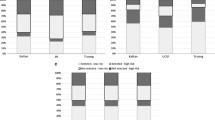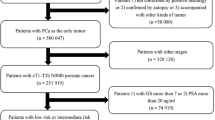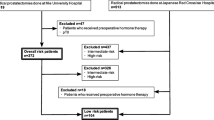Abstract
Purpose
Low-risk prostate cancer patients clinically eligible for active surveillance can also be managed surgically. We evaluated the pathologic outcomes for this cohort that was treated by radical prostatectomy and devised nomograms to predict patients at risk of upgrading and/or upstaging.
Materials and methods
Seven hundred and fifty patients treated by radical prostatectomy from Jan 2005 to the present fulfilled conventional active surveillance criteria and formed the study cohort. Preoperative data on standard clinicopathologic parameters were available. The radical prostatectomy specimens were graded and staged, and any upgrading to Gleason sum >6 or upstaging to ≥pT3 (‘worsening prognosis’) were noted. Multivariable logistic regression models were used to develop predictive nomograms.
Results
Of the 750 patients, 303 (40.4%) patients were either upgraded or upstaged. Multivariable analysis found that preoperative PSA, number of positive cores, and prostate volume were significantly predictive of worsening prognosis and formed the nomogram criteria.
Conclusions
Of patients deemed eligible for active surveillance based on conventional criteria, 40.4% have worse prognostic factors after radical prostatectomy. Current active surveillance criteria may be too relaxed, and the use of nomograms which we have devised, may aid in counseling primary prostate cancer patients considering active surveillance as their therapy of choice.



Similar content being viewed by others
References
Jemal A, Siegel R, Ward E, Hao Y, Xu J, Thun MJ (2009) Cancer statistics, 2009. CA Cancer J Clin 59(4):225–249
Cooperberg MR, Broering JM, Kantoff PW, Carroll PR (2007) Contemporary trends in low risk prostate cancer: risk assessment and treatment. J Urol 178(3 Pt 2):S14–S19
Klotz L (2007) Active surveillance for favorable risk prostate cancer: rationale, risks, and results. Urol Oncol 25(6):505–509
Carter HB, Kettermann A, Warlick C, Metter EJ, Landis P, Walsh PC et al (2007) Expectant management of prostate cancer with curative intent: an update of the Johns Hopkins experience. J Urol 178(6):2359–2364 discussion 2364–2355
Epstein JI, Walsh PC, Carmichael M, Brendler CB (1994) Pathologic and clinical findings to predict tumor extent of nonpalpable (stage T1c) prostate cancer. JAMA 271(5):368–374
D’Amico AV, Renshaw AA, Arsenault L, Schultz D, Richie JP (1999) Clinical predictors of upgrading to Gleason grade 4 or 5 disease at radical prostatectomy: potential implications for patient selection for radiation and androgen suppression therapy. Int J Radiat Oncol Biol Phys 45(4):841–846
Fukagai T, Namiki T, Namiki H, Carlile RG, Shimada M, Yoshida H (2001) Discrepancies between Gleason scores of needle biopsy and radical prostatectomy specimens. Pathol Int 51(5):364–370
Pinthus JH, Witkos M, Fleshner NE, Sweet J, Evans A, Jewett MA et al (2006) Prostate cancers scored as Gleason 6 on prostate biopsy are frequently Gleason 7 tumors at radical prostatectomy: implication on outcome. J Urol 176(3):979–984 discussion 984
Harrell FE Jr, Lee KL, Mark DB (1996) Multivariable prognostic models: issues in developing models, evaluating assumptions and adequacy, and measuring and reducing errors. Stat Med 15(4):361–387
Schröder FH, Hugosson J, Roobol MJ, Tammela TL, Ciatto S, Nelen V et al (2009) Screening and prostate-cancer mortality in a randomized European study. N Engl J Med 360(13):1320–1328
Patel MI, DeConcini DT, Lopez-Corona E, Ohori M, Wheeler T, Scardino PT (2004) An analysis of men with clinically localized prostate cancer who deferred definitive therapy. J Urol 171(4):1520–1524
Eggener SE, Mueller A, Berglund RK, Ayyathurai R, Soloway C, Soloway MS et al (2009) A multi-institutional evaluation of active surveillance for low risk prostate cancer. J Urol 181(4):1635–1641 discussion 1641
Dong F, Jones JS, Stephenson AJ, Magi-Galluzzi C, Reuther AM, Klein EA (2008) Prostate cancer volume at biopsy predicts clinically significant upgrading. J Urol 179(3):896–900 discussion 900
Conti SL, Dall’era M, Fradet V, Cowan JE, Simko J, Carroll PR (2009) Pathological outcomes of candidates for active surveillance of prostate cancer. J Urol 181(4):1628–1633 discussion 1633–1624
Smaldone MC, Cowan JE, Carroll PR, Davies BJ (2010) Eligibility for active surveillance and pathological outcomes for men undergoing radical prostatectomy in a large, community based cohort. J Urol 183(1):138–143
Freedland SJ, Isaacs WB, Platz EA, Terris MK, Aronson WJ, Amling CL et al (2005) Prostate size and risk of high-grade, advanced prostate cancer and biochemical progression after radical prostatectomy: a search database study. J Clin Oncol 23(30):7546–7554
Briganti A, Chun FK, Suardi N, Gallina A, Walz J, Graefen M et al (2007) Prostate volume and adverse prostate cancer features: fact not artifact. Eur J Cancer 43(18):2669–2677
Turley RS, Hamilton RJ, Terris MK, Kane CJ, Aronson WJ, Presti JC Jr et al (2008) Small transrectal ultrasound volume predicts clinically significant Gleason score upgrading after radical prostatectomy: results from the SEARCH database. J Urol 179(2):523–527 discussion 527–528
Kassouf W, Nakanishi H, Ochiai A, Babaian KN, Troncoso P, Babaian RJ (2007) Effect of prostate volume on tumor grade in patients undergoing radical prostatectomy in the era of extended prostatic biopsies. J Urol 178(1):111–114
Kulkarni GS, Lockwood G, Evans A, Toi A, Trachtenberg J, Jewett MA et al (2007) Clinical predictors of Gleason score upgrading: implications for patients considering watchful waiting, active surveillance, or brachytherapy. Cancer 109(12):2432–2438
San Francisco IF, DeWolf WC, Rosen S, Upton M, Olumi AF (2003) Extended prostate needle biopsy improves concordance of Gleason grading between prostate needle biopsy and radical prostatectomy. J Urol 169(1):136–140
Freedland SJ, Kane CJ, Amling CL, Aronson WJ, Terris MK, Presti JC Jr (2007) Upgrading and downgrading of prostate needle biopsy specimens: risk factors and clinical implications. Urology 69(3):495–499
Turley RS, Terris MK, Kane CJ, Aronson WJ, Presti JC, Amling CL et al (2008) The association between prostate size and Gleason score upgrading depends on the number of biopsy cores obtained: results from the shared equal access regional cancer hospital database. BJU Int 102(9):1074–1079
Venkitaraman R, Norman A, Woode-Amissah R, Fisher C, Dearnaley D, Horwich A et al (2007) Predictors of histological disease progression in untreated, localized prostate cancer. J Urol 178(3 Pt 1):833–837
Dall’Era MA, Cooperberg MR, Chan JM, Davies BJ, Albertsen PC, Klotz LH et al (2008) Active surveillance for early-stage prostate cancer: review of the current literature. Cancer 112(8):1650–1659
Thong AE, Shikanov S, Katz MH, Gofrit ON, Eggener S, Zagaja GP et al (2008) A single microfocus (5% or less) of Gleason 6 prostate cancer at biopsy—can we predict adverse pathological outcomes? J Urol 180(6):2436–2440
Allsbrook WC Jr, Mangold KA, Johnson MH, Lane RB, Lane CG, Amin MB et al (2001) Interobserver reproducibility of Gleason grading of prostatic carcinoma: urologic pathologists. Hum Pathol 32(1):74–80
Berglund RK, Masterson TA, Vora KC, Eggener SE, Eastham JA, Guillonneau BD (2008) Pathological upgrading and up staging with immediate repeat biopsy in patients eligible for active surveillance. J Urol 180(5):1964–1967
Acknowledgments
Dr. Prasanna Sooriakumaran is the ACMI Corp. Endourological Society fellow and also receives financial support from Prostate UK; Dr. Paul Christos is partially supported by the following grant: Clinical Translational Science Center (CTSC) (UL1-RR024996); Dr. Ashutosh Tewari is the endowed Ronald P. Lynch Professor of Urologic-Oncology, the Director of the Prostate Cancer Institute, and Director of the Lefrak Center for Robotic Surgery, and has received grants in the past from Intuitive Surgical Inc. and the National Institute of Health. However, this work was not supported by such grants.
Author information
Authors and Affiliations
Corresponding author
Additional information
Prasanna Sooriakumaran and Abhishek Srivastava contributed equally to the work in this manuscript.
Rights and permissions
About this article
Cite this article
Sooriakumaran, P., Srivastava, A., Christos, P. et al. Predictive models for worsening prognosis in potential candidates for active surveillance of presumed low-risk prostate cancer. Int Urol Nephrol 44, 459–470 (2012). https://doi.org/10.1007/s11255-011-0020-0
Received:
Accepted:
Published:
Issue Date:
DOI: https://doi.org/10.1007/s11255-011-0020-0




